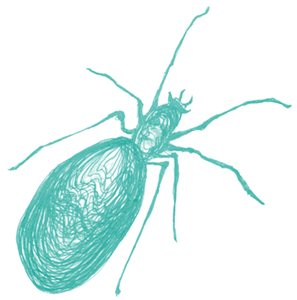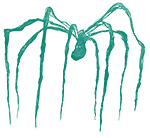They usually are hiding in plain sight—between tree tips and branches of shrubs, under fallen logs, in hollow tree trunks, on tall grasses and shrubs. When the weather is right, usually on dewy mornings, landscapes shimmer with Mother Nature’s lace: silky spider webs dangling from limbs or suspended between vegetation. Every thread vibrates, moving rhythmically in response to natural forces.
The classic orb web is beautiful in its design. The structures are complex and intricately crafted, with dozens of small spokes leading to a spiral in the center. Only the spiral is sticky.
Spiders are precise dew collectors
Spider webs are one of an assortment of water-hoarding materials that exist in nature. The delicate, but resilient web of threads built to capture prey and lay eggs also attract dew drops. The sticky protein fibers spun by spiders are crucial for capturing dew.
Dew is moisture that forms when atmospheric temperatures drop and objects cool down. The water condenses—changes from a gas to a liquid—onto any solid surface.
Liquid beads on curved surfaces
Spider webs are unique dew collectors because of their intricate, curved, sticky surfaces and the physical forces at play. Scientists have observed that when spider silk gets wet, rough-textured bumps form along the otherwise smooth fiber of the silk.
The smooth and bumpy textures create differences in pressure and energy that lets water collect into beads instead of having it run off or spread out over the surface. The distinct droplets, called ’spindle knots,’ are held in place by surface tension, the web’s structure, and interlocking threads.
Global water shortages
The United Nations predicts that two-third of the world’s population will face water shortages by 2050. Currently, billions of people around the world lack access to clean drinking water.
The two conventional methods used to produce freshwater are desalination and wastewater treatment. Both consume a large amount of energy and require complex technical equipment.
Biomimicking spider webs to harvest water from air
Dew-spangled webs have inspired low tech water collection solutions for parched lands. Specially engineered nets, woven with spider silk-like fibers, are available to extract water from air using no energy. The enormous flat nets, suspended vertically between steel stands, trap fog via condensation in some of the most arid parts of the world.
Suitable locations are usually hills with frequent cloud movement over their surfaces. In high altitude towns in Peru, fibrous mesh fog collectors provide drinking water and enough water for villagers to have gardens and grow trees.
Ephemeral gems
The delicate and alive strings of dew drops spiders help create are ephemeral gems. The glistening beads reveal unseen beauty and the spider webs serve as a blueprint for water collection strategies that support life and hydrate the planet.




